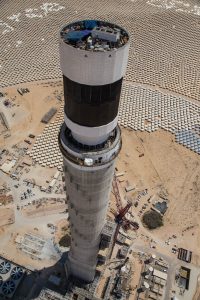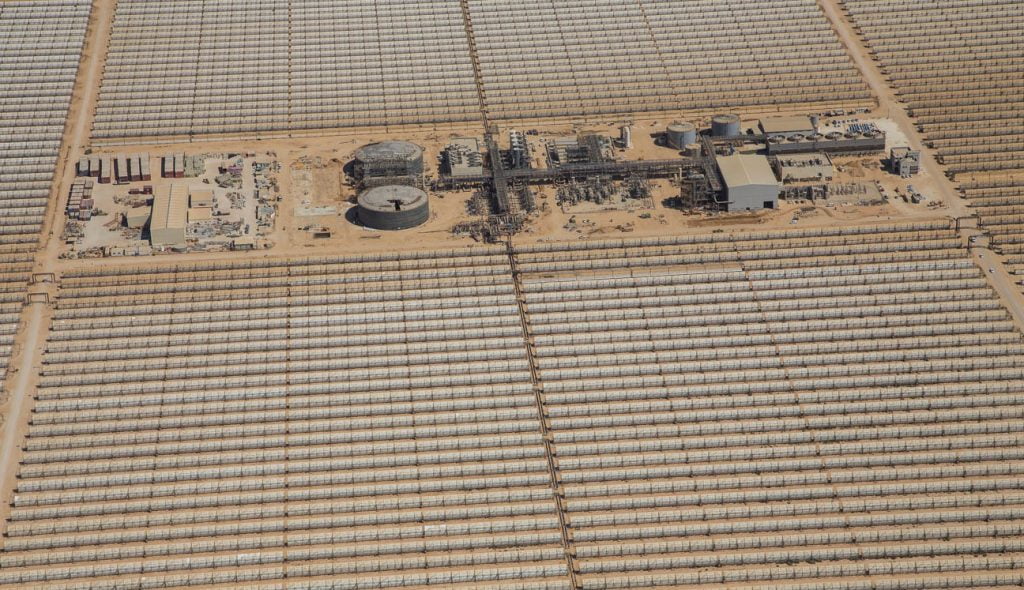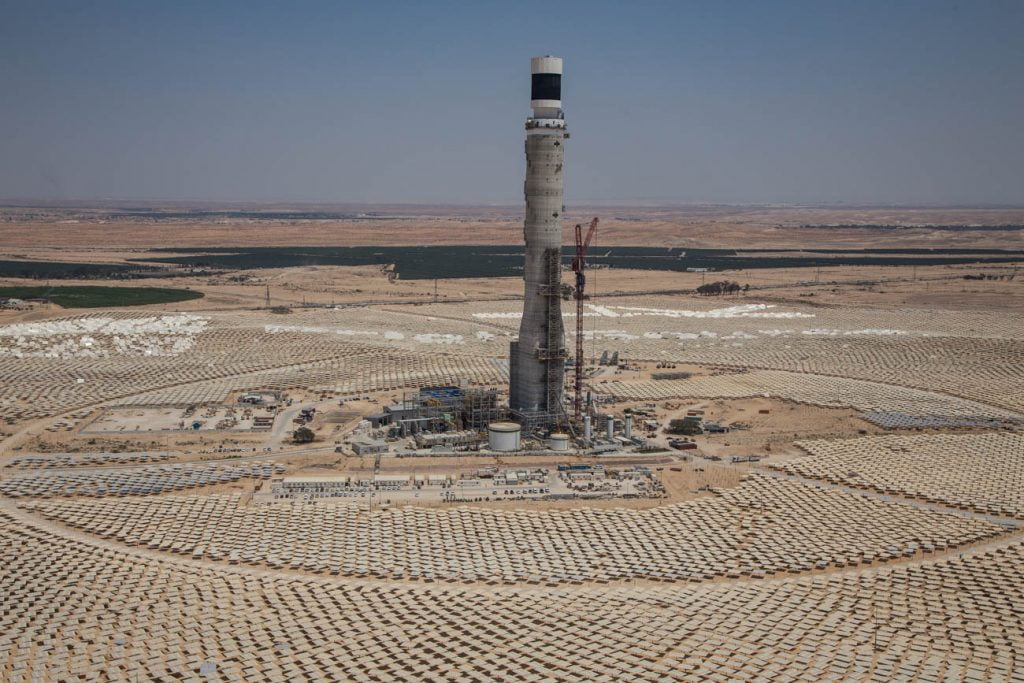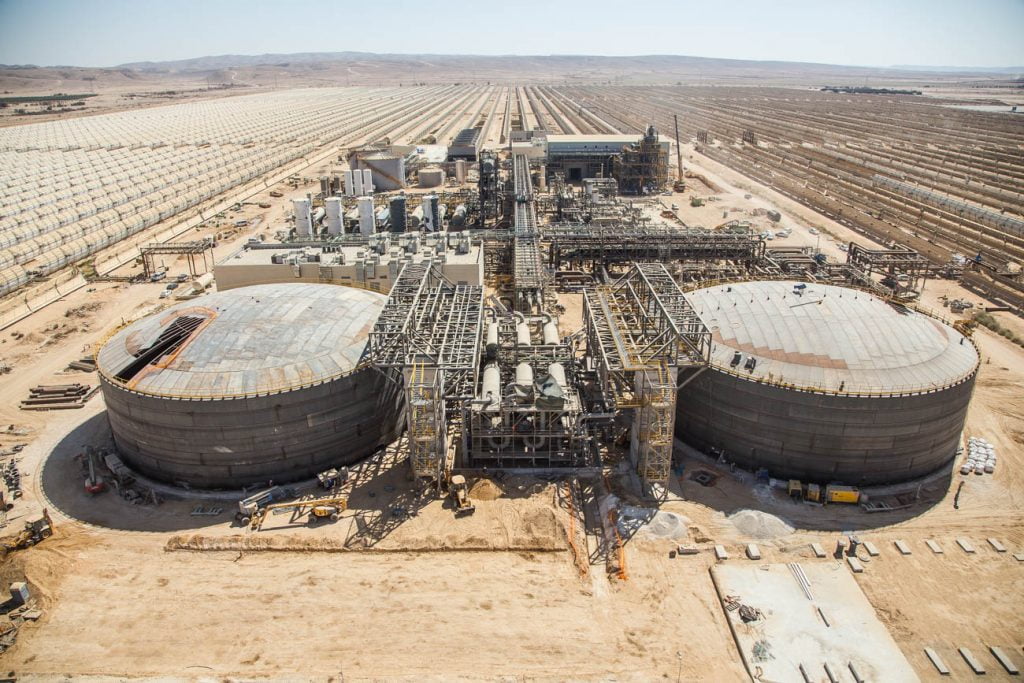When Israel’s first prime minister, David Ben-Gurion, expressed his vision over 60 years ago “to make the desert bloom,” he may not have expected a multi-billion-dollar initiative that combines three massive solar power plants, the world’s tallest solar tower, and a wastewater treatment plant, all housed near a tiny Israeli community of roughly 500 people in the Negev desert.
The ambitious projects were launched in late 2014, following an Israeli government-set objective of having renewable energy contribute to 10 percent of electricity generation by 2020. And almost all are near completion.
SEE ALSO: Inna Braverman: The Young Woman With Big Plans To Harness The World’s Oceans For Clean Energy
Two of the projects are located side-by-side in a solar complex dubbed Ashalim, named after the Israeli town adjacent to the sites, some 25 miles (about 40 kilometers) south of Beersheba in the Ramat Hanegev Regional Council. The projects tout different technologies and are run by separate consortiums.
The first is a massive, $1.1 billion, 121 MW thermo-solar power plant spread over 988 acres (about 4 square kilometers) of land called Negev Energy. It is made up of 28,000 tons of steel and some 500,000 parabolic mirrors that collect light to be converted to energy. The plant plans to reduce approximately 245,000 tons of carbon dioxide emissions per year – the equivalent of removing 50,000 vehicles from the road – and provide clean power solely from renewable energy to 60,000 households in Israel by 2020.
The second project is a smaller plant across 741 acres (almost 3 square kilometers) built on concentrated solar power, which includes a massive, 820-foot (250-meter) solar tower, the largest such tower in the world and playfully dubbed the “tower of power.” Called Megalim Solar Power, and with an estimated cost of $800 million, it includes a solar field with over 50,000 software-controlled heliostat mirrors that concentrate sunlight atop a solar receiver steam generator.
Nearby, the third project is a 35 MW solar plant based on photovoltaic, or PV, power – that is, the use of solar cells to generate electrical power. The initiative came with an initial investment of some $100 million and is dubbed the Ashalim SUN project.
The fourth initiative, the Ramat Hanegev Cogeneration Waste Water Treatment and Demineralization Plant, is part of a government plan to support the solar facilities which also includes bolstering the infrastructure surrounding the complexes.
Technology and investment
Negev Energy CEO Didi Paz tells NoCamels that the plant uses innovative technology so advanced that it is a game-changer.
“Like Silicon Valley in California, we are the Israel Solar Valley,” Paz tells NoCamels.
Based on parabolic technology – technology that uses a solar thermal collector to gather energy – the Negev Energy plant is leveraged by one of the largest molten salt storage systems in the world, which means energy is not only collected, it’s also stored. Even on a cloudy day or after sunset, this innovative technology provides the ability to store an additional four and a half hours of full capacity energy every day – adding up to an entire 18 hours worth of daily operation, Paz explains.
“Negev Energy is unique in that this project introduces energy storage to Israel,” Paz tells NoCamels. “This is the first time Israeli technology is able to store energy, adding to an integral part of the solar energy process,” he says.
The Negev Energy project is a 50 percent subsidiary of Israel’s Shikun & Binui Group, Paz’s former employer. The other two owners are the Noy Fund, and TSK, a Spanish company specializing in turn-key projects for energy generating power plants. Negev Energy Chairman Pinchas (Pini) Cohen also serves as chairman of the Noy Fund, and previously served as president and CEO of Africa Israel, an international holding and investments group, as well as chairman of some of the most prominent leading real estate and investment companies in Israel.
The Noy Fund is also part of the consortium that won the tender for the Megalim Solar Power plant. The other two members are California-based energy corporation BrightSource and GE Renewable Energy, a subsidiary of General Electric.
Sign up for our free weekly newsletter
SubscribeMegalim says that the key to its technology “is the next-generation solar field design, optimization software and a control system that enable the creation of high pressure, high-temperature steam” that is then used to generate electrical power. Megalim says its aim is to generate “renewable electric power equivalent to the needs of about 120,000 households” in Israel.
Megalim Solar Power’s chief executive Eran Gartner told the Associated Press last year that the project “is the most significant single building block in Israel’s commitment to CO2 reduction and renewable energy.”
Megalim is modeled after the world’s largest concentrated solar tower project, the Ivanpah Solar Electric Generating System, a 390 MW plant in California, and is looking into an expansion of its project that would include a second tower and a molten salt storage system, similar to the one built by Negev Energy, according to a presentation seen by NoCamels.
Both Megalim and Negev Energy were developed using the build-operate-transfer (BOT) model, where after years of construction and another 25 years of successful operation, the project will then be transferred to the state.
The upsides and downsides
Along with the environmentally friendly approach to renewable energy and solar power, the projects have two other important elements: employment and tourism.
With thousands of construction and maintenance employees, many from the Bedouin community from areas in southern Israel, the initiatives contribute greatly to local employment.
The project is also predicted to enhance regional development by promoting environmental planning and boosting tourism with its unique observation point overlooking the fields of mirrors with a desert backdrop, which will be accessible by summer.
“Tourists will absolutely be able to enjoy the enormous sight, viewing it from the platform of the vantage point,” says Paz.
The Ramat Hanegev Regional Council has said that it is preparing the groundwork for tourist curiosity and are setting-up “scenic lookout points and lodging accommodations in the region for visiting delegations and traveling groups.”
But if boosting employment and generating tourist attraction is the silver lining, the cloud is the effect on the residents of the town of Ashalim and the surrounding areas. According to Paz, in order to make life easier for them, the Negev Energy project has kept them updated on the progress, and is ultimately providing better infrastructure for everyone.
Paz says that despite the natural resources consumed by the plants, they meet advanced international environmental standards and aim for sustainability by using water from the desalination plant and recycling the thermal oil produced by the mirrors.
Israel may not often be referred to as a renewable energy leader, but with these projects and future ones, it may well be on its way to becoming a powerhouse.
Michael Noonan contributed to this report.
Related posts

Editors’ & Readers’ Choice: 10 Favorite NoCamels Articles

Forward Facing: What Does The Future Hold For Israeli High-Tech?

Impact Innovation: Israeli Startups That Could Shape Our Future








Facebook comments